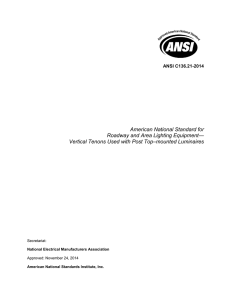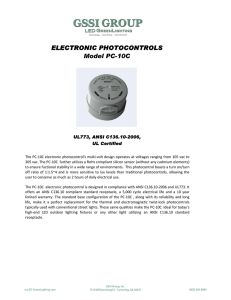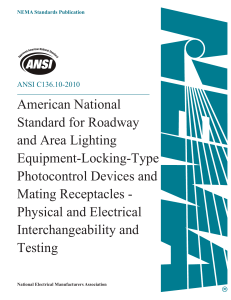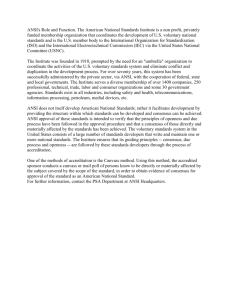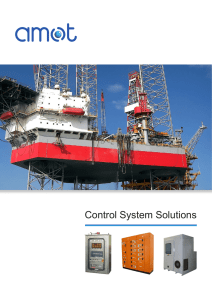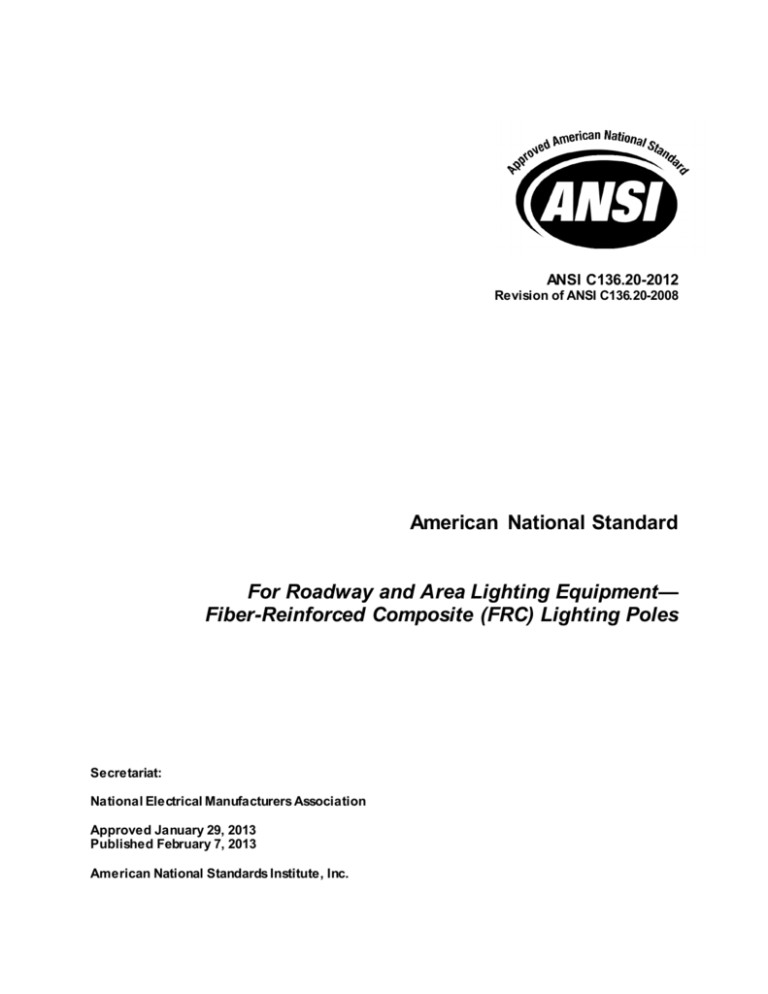
ANSI C136.20-2012
Revision of ANSI C136.20-2008
American National Standard
For Roadway and Area Lighting Equipment—
Fiber-Reinforced Composite (FRC) Lighting Poles
Secretariat:
National Electrical Manufacturers Association
Approved January 29, 2013
Published February 7, 2013
American National Standards Institute, Inc.
ANSI C136.20-2012
Page ii
NOTICE AND DISCLAIMER
The information in this publication was considered technically sound by the consensus of persons
engaged in the development and approval of the document at the time it was developed. Consensus
does not necessarily mean that there is unanimous agreement among every person participating in the
development of this document.
American National Standards Institute (ANSI) standards and guideline publications, of which the
document contained herein is one, are developed through a voluntary consensus standards development
process. This process brings together volunteers and/or seeks out the views of persons who have an
interest in the topic covered by this publication. While NEMA administers the process and establishes
rules to promote fairness in the development of consensus, it does not write the document and it does not
independently test, evaluate, or verify the accuracy or completeness of any information or the soundness
of any judgments contained in its standards and guideline publications.
NEMA disclaims liability for any personal injury, property, or other damages of any nature whatsoever,
whether special, indirect, consequential, or compensatory, directly or indirectly resulting from the
publication, use of, application, or reliance on this document. NEMA disclaims and makes no guaranty or
warranty, express or implied, as to the accuracy or completeness of any information published herein,
and disclaims and makes no warranty that the information in this document will fulfill any of your particular
purposes or needs. NEMA does not undertake to guarantee the performance of any individual
manufacturer or seller’s products or services by virtue of this standard or guide.
In publishing and making this document available, NEMA is not undertaking to render professional or
other services for or on behalf of any person or entity, nor is NEMA undertaking to perform any duty owed
by any person or entity to someone else. Anyone using this document should rely on his or her own
independent judgment or, as appropriate, seek the advice of a competent professional in determining the
exercise of reasonable care in any given circumstances. Information and other standards on the t opic
covered by this publication may be available from other sources, which the user may wish to consult for
additional views or information not covered by this publication.
NEMA has no power, nor does it undertake to police or enforce compliance with the contents of this
document. NEMA does not certify, test, or inspect products, designs, or installations for safety or health
purposes. Any certification or other statement of compliance with any health or safety–related information
in this document shall not be attributable to NEMA and is solely the responsibility of the certifier or maker
of the statement.
© Copyright 2012 by National Electrical Manufacturers Association
ANSI C136.20-2012
Page iii
American
National
Standard
Approval of an American National Standard requires verification by ANSI that
the requirements for due process, consensus, and other criteria for approval
have been met by the standards developer.
Consensus is established when, in the judgment of the ANSI Board of
Standards Review, substantial agreement has been reached by direct and
materially affected interests. Substantial agreement means much more than a
simple majority, but not necessarily unanimity. Consensus requires that all views
and objections be considered, and that a concerted effort be made toward their
resolution.
The use of American National Standards is completely voluntary; their existence
does not in any respect preclude anyone, whether he has approved the
standards or not, from manufacturing, marketing, purchasing, or using products,
processes, or procedures not conforming to the standards.
The American National Standards Institute does not develop standards and will
in no circumstances give an interpretation of any American National Standard.
Moreover, no person shall have the right or authority to issue an interpretation of
an American National Standard in the name of the American National Standards
Institute. Requests for interpretations should be addressed to the secretariat or
sponsor whose name appears on the title page of this standard.
CAUTION NOTICE: This American National Standard may be revised or
withdrawn at any time. The procedure of the American National Standards
Institute requires that action be taken periodically to reaffirm, revise, or withdraw
this standard. Purchasers of American National Standards may receive current
information on all standards by calling or writing the American National
Standards Institute.
Published by:
National Electrical Manufacturers Association
1300 North 17th Street, Rosslyn, VA 22209
Copyright 2012 by National Electrical Manufacturers Association.
All rights reserved including translation into other languages, reserved under the Universal Copyright
Convention, the Berne Convention for the Protection of Literary and Artistic Works, and the International
and Pan American Copyright Conventions.
No part of this publication may be reproduced in any form, in an electronic retrieval system or otherwise, and without the pr ior
written permission of the publisher.
Printed in the United States of America.
© Copyright 2012 by National Electrical Manufacturers Association
ANSI C136.20-2012
Page iv
<This page intentionally left blank.>
© Copyright 2012 by National Electrical Manufacturers Association
ANSI C136.20-2012
Page v
Table of Contents
1
SCOPE....................................................................................................................... 1
2
REFERENCES .......................................................................................................... 1
2.1
Normative References ................................................................................. 1
2.2
Informative References ............................................................................... 1
3
DEFINITIONS ............................................................................................................ 1
4
GENERAL.................................................................................................................. 2
4.1
5
Pole Strength ................................................................................................ 2
SHAFTS ..................................................................................................................... 3
5.1
Composition of Shafts................................................................................. 3
5.2
Exterior Surface of Shafts........................................................................... 3
5.3
Direct-burial Poles ....................................................................................... 3
5.4
Anchor Base Poles ...................................................................................... 3
5.5
Poles for Post-top Luminaires ................................................................... 3
6
BOLT CIRCLES ........................................................................................................ 4
7
LUMINAIRE SUPPORT ARMS ................................................................................ 4
8
WIRING AND WIRING ACCESS ............................................................................. 4
8.1
Wiring ............................................................................................................. 4
8.2
Wiring Access ............................................................................................... 4
9
IDENTIFICATION ...................................................................................................... 5
10
PERFORMANCE ...................................................................................................... 5
10.1
General........................................................................................................... 5
10.2
Physical ......................................................................................................... 5
11
BREAKAWAY SUPPORTS ..................................................................................... 6
12
POLE DEFLECTION MEASUREMENTS................................................................ 6
12.1
General........................................................................................................... 6
12.2
Method I ......................................................................................................... 6
12.3
Method II ........................................................................................................ 6
12.4
Method III ....................................................................................................... 7
© Copyright 2012 by National Electrical Manufacturers Association
ANSI C136.20-2012
Page vi
FIGURES
FIGURE 1 BOLT CIRCLE……………………………………………………………………3
FIGURES 2A, 2B, 2C DEFLECTION MEASUREMENT METHODS…………………...8
© Copyright 2012 by National Electrical Manufacturers Association
ANSI C136.20-2012
Page vii
FOREWORD
At the time this standard was approved, the ANSI C136 committee was composed of the following
members:
Acuity Brands Lighting
Alabama Power
American Electric Lighting
Ceravision
City of Kansas City, Missouri
City of Los Angeles, Bureau of Street Lighting
Cooper Lighting
Duke Energy
Edison Electric Institute
EPRI
Florida Power and Light
FRE Composites Inc.
GE Lighting
Georgia Power Company
Gulf Power Company
Hapco Aluminum Pole Products
Holophane An Acuity Brands Company
Hubbell Lighting, Inc.
Intelligent Illuminations Inc.
Kauffman Consulting, LLC
LITES
National Grid
Pacific Northwest National Laboratory
Philips HADCO
Philips LUMEC
PNNL
Progress Energy
SELC Lighting
Shakespeare Composite Structures
South Carolina Electric & Gas Co.
SouthConn Technologies, Inc.
StressCrete Ltd/King Luminaire Co., Inc.
Sunrise Technologies, Inc./FP Outdoor Lighting Controls
TE Connectivity
Utility Metals Division of Fabricated Metals, LLC
Valmont Industries, Inc.
Vamas Engineering and Consultants
Vandal Shields
Xcel Energy
© Copyright 2012 by National Electrical Manufacturers Association
ANSI C136.20-2012
Page 1
1 SCOPE
This standard applies to fiber-reinforced composite (FRC) lighting poles used for roadway and area
lighting. This standard includes nomenclature, dimensional data, performance criteria, and some
interchangeability features for standard poles as well as those that must meet breakaway requirements
for poles as described in AASHTO LTS Standard Specifications for Structural Supports for Highway
Signs, Luminaires, and Traffic Signals.
2
REFERENCES
2.1
Normative References
This standard incorporates by undated reference provisions from other publications. These normative
references are cited at the appropriate places in the text, and the publications are listed below. For
undated references, the latest edition of the publication referred to applies (including amendments).
AASHTO LTS Standard Specifications for Structural Supports for Highway Signs, Luminaires, and Traffic
Signals
ANSI C136.3 American National Standard for Roadway and Area Lighting Equipment—Luminaire
Attachments
ANSI C136.13 American National Standard for Roadway and Area Lighting Equipment—Metal Brackets
of Wood Poles Used in Roadway Lighting
ANSI C136.21 American National Standard for Roadway and Area Lighting Equipment—Vertical Tenons
Used with Post Top-Mounted Luminaires
ASTM G154 Practice for Operating Fluorescent Light Apparatus for UV Exposure of Nonmetallic
Materials
2.2
Informative References
This standard is intended to be used in conjunction with the following publications. The latest edition of
the publication applies (including amendments).
ASTM A153 Specifications for Zinc Coating (Hot-Dip) on Iron and Steel Hardware
3
DEFINITIONS
Anchor Base: A feature attached to the bottom end of a pole designed to be mounted on an
accommodating platform.
Anti-Rotational Device: A device attached to the pole at a point below ground level to ensure the pole
does not twist after installed and in service.
Arm: A structural member approximately perpendicular to a pole, which supports a luminaire.
Bolt Circle: The diameter of a circle that will intersect the centerline of the anchor bolts that are spaced
equal distance to each other.
Direct Burial: A term used to refer to a pole designed to be supported by surrounding earth or other
material.
© Copyright 2012 by National Electrical Manufacturers Association

